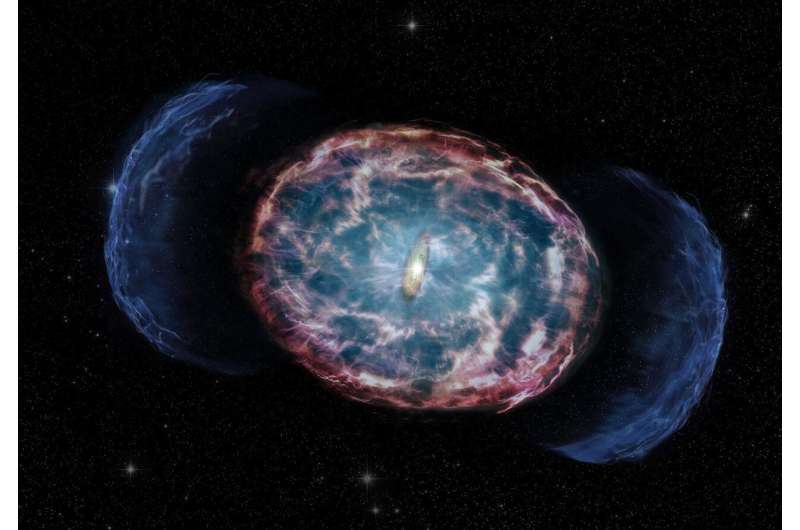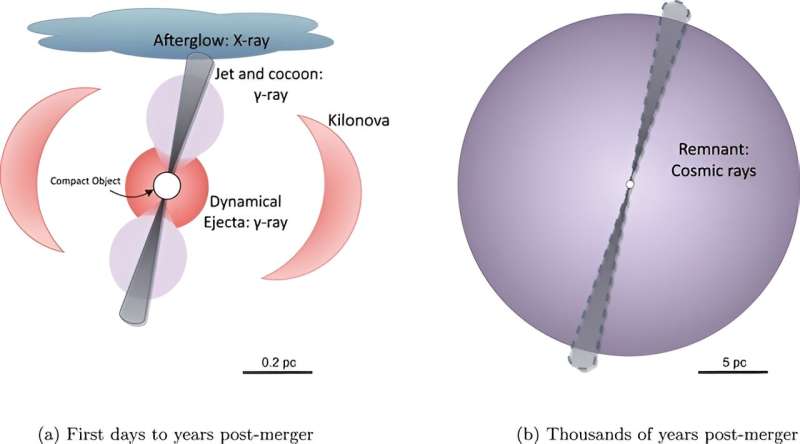This article has been reviewed according to Science X's editorial process and policies. Editors have highlighted the following attributes while ensuring the content's credibility:
fact-checked
trusted source
proofread
How dangerous are kilonovae?

When we look up at the sky on a particularly dark night, there is a sense of timelessness. We might see the flash of a meteor, and occasionally a comet is visible to the naked eye, but the cold and distant stars are unchanging. Or so it seems. There can also be a sense of calm, that despite all the uncertainty of the world, the stars will always watch over us.
So it's hard to imagine that light years away there could be a lurking event that poses an existential threat to humanity. That threat is extremely tiny, but not zero, and it is the focus of a recent paper published in The Astrophysical Journal.
The study focuses on kilonovae, which can occur when either two neutron stars collide, or a neutron star collides with a stellar-mass black hole. Kilonovae are similar to supernovae, but much more intense. In the paper, the authors look at a particular kilonova known as GW170817. It was detected by the LIGO and Virgo gravitational wave observatories in 2017, and seen as a gamma-ray burst by the Fermi and INTEGRAL space telescopes. Since we have both optical and gravitational observations, the energy of the kilonova can be calculated quite well.
The team took this data and combined it with computer simulations on kilonovae. They wanted to estimate the minimum safe distance of a kilonova. In other words, how close to us could one go off and still be a harmless light show? What they found was that there are several safe distances, depending on which aspect of the supernova poses a threat.
One threat would be the X-ray afterglow. When neutron stars collide, a jet of high-energy gamma rays can stream from their common polar region. These jets collide with interstellar gas and create an afterglow of intense X-rays. The intensity of this glow could ionize Earth's atmosphere, leaving us exposed to things such as solar flares and ultraviolet radiation. But only if the kilonova occurred within about 16 light-years of Earth. The gamma rays themselves could pose a similar threat, but only to within about 13 light-years.

But as the team found, the greater threat wouldn't reach us at the speed of light. After the explosion, a shockwave from the collision would expand away from the kilonova over the span of about a thousand years. When the shockwave collides with interstellar gas and dust, it creates intense cosmic rays. If such a stream of cosmic rays reached us it could vaporize our atmosphere, killing almost all life on Earth. But this would only pose a threat to a distance of about 40 light-years.
GW170817 occurred about 130 million light-years away, so it poses absolutely no threat to us. Even if one were to occur in our stellar neighborhood, it would likely be too distant to pose any harm. As far as we know, there are no binary neutron stars within 40 light-years that will merge any time soon.
So there is nothing for us to worry about. Mostly what this study shows is that throughout the cosmos kilonovae can pose a threat to life from time to time, but that threat is not large enough to wipe out a large fraction of worlds. We can face cosmic dangers, but thankfully a kilonova isn't one of them.
More information: Haille M. L. Perkins et al, Could a Kilonova Kill: A Threat Assessment, The Astrophysical Journal (2024). DOI: 10.3847/1538-4357/ad12b7
Provided by Universe Today





















